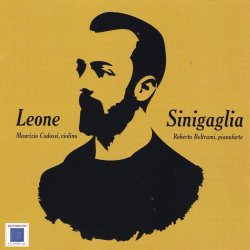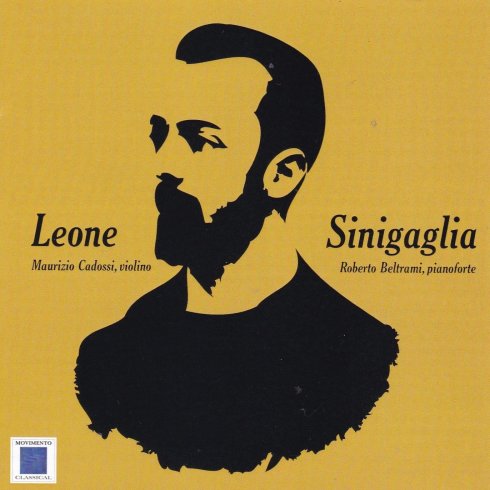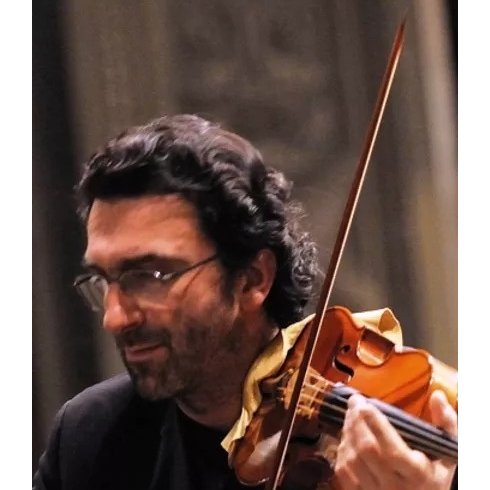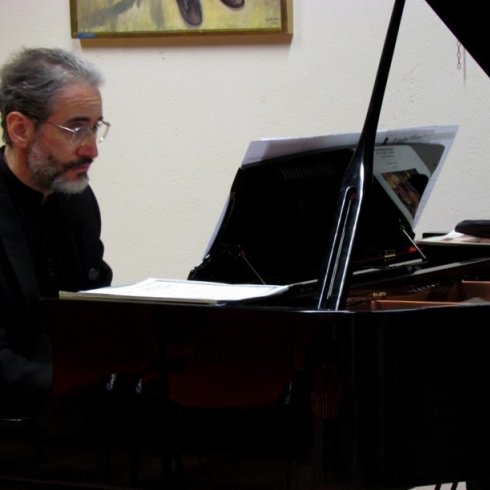

Even today the knowledge of twentieth century Italian music is commonly based on the representa-tion of some works belonging to a restricted group of authors. Far from having acquired an objective and global vision -especially as regards the musical production of the first half of the century -cur-rently studying music are favoring the archive rediscovery tied to stili little known figures of the Italian landscape, providing documents fora redefinition less stereotypical of the twentieth century. As part of this musical research season comes the realization of this CD, ali focused on the repertory for violin and piano by Leone Sinigaglia, with Lirische Drei Stucke Op.12 and Op.13 Drei Romantische Stucke, Vier Kleine Stucke Jur Violin with Klavierbegleitung op.25 and, finally, the Sonata far violin and piano op.44.
Bom in Turin in 1868, Sinigaglia performs music studying violin, piano and composition, among others, with Giovanni Bolzoni and Federico Buffaletti. In 1893 he moved to Vienna, where he studied under Eusebius Mandyczewski and knows Brahms. Later, in 1900, he went to Prague to study instru-mentation with Antonin Dvorak, which transmits at Sinigaglia interest in folk songs.
He returned to Turin, began in 1902 to collect melodies and lyrics of the songs from the Piedmontese peasant voice of the Turin hi!ls, a job that lasts for a decade and brings him to collect about 500 origi-nai melodies. Some of these melodies are then elaborated by him far voice and piano, such as occurs in the collection of 36 old folk songs of Piedmont, published in Leipzig between 1914 and 1927, and other organic. also it composed between 1902 and 1910 various works that made him famous: Pied-mont Rhapsody far Violinand Orchestra, String Quarte/ op.27, Piedmont 2Dances far Orchestra Op.31, The Venetian Quarrels (1907),Piedmont Suite far orchestra (1909), dedicated to Toscanini. Secluded spends the years between the two world wars, aware of the profound changes occurring in the field of music, but the rare music written by him in this period is always subject to review by of the largest musical institutions of that time.
Enough to mention, among others, the two appearances at the International Music Festival of Venice of 1930 and 1932, more than any other event focused on new trends in music and composition in piace. In 1936, the year of the publication of the Sonata far violin and piano op.44, was named Academic of Santa Cecilia.
Enough to mention, among others, the two appearances at the International Music Festival of Venice of 1930 and 1932, more than any other event focused on new trends in music and composition in piace. 1936, year of the publication of the Sonata far violin and piano op.44, was named Academic of Santa Cecilia.
The Lirische Drei Stucke op.12 are published in Berlin in 1898, far the pub!isher Simrock. The three songs
-
Larghetto, Shaken and Adagio
-
that make up the collection belong to the period of stay of the composer in Vienna. They are affected by the experiences of the late Romantic and Centrai European environment, as Wilhelm Hansenin Kopenaghen well as the Drei Romantische Stiicke op.13 , published by in 1902. Another three short pieces (Cavatine, Intermezzo and Erinnerung) which are enhanced by the expressive qualities of two instruments, and among them, especially, Erinnerung, far his deep introspective style. A different taste, the Vier Kleine Stucke far Violin with Klavierbegleitung op.25, collection published in ( London by Schott and Co. in 1903 and dedicated to the violinist Arrigo Serata (1877-1948). The songs included the op. 25 - Albumblatt, Capriccio old, Bagatelle and Saltarello they quickly become very well known and come in a repertoire of famous violinists such as Ferenc Vecsey and Mischa Elman. The lively character that pervades the four pieces is a clear example of a peculiar aspect of the writing of Sinigaglia, which is prepared, regardless of the influence that is due to the popular song, we can identify two main lines of inspiration. One, serene and joyful, of which the best example is the Overture Baruffe Chiozzotte (1905); the other, more interior, in veiled traits of melancholy, typical of a part of the chamber output. The focus of this publication is without doubt the Sonata far violin and piano op.44. Divided into three movements (Allegro moderato, Adagio and Allegro with a spirit) and consists of a Sinigaglia almost seventy, in the Sonata relive the experiences of the late Romantic music, however, light color and musicality of Piedmontese folk song, an essential element in the repertoire of composer. About the Sonata far Violin and Piano op.44, it reads a magazine of the time: Flourished on the edge of musical nineteenth experiences - especially the Brahms - the music of Sinigaglia pushes today as an offshoot of a distant world; yet not for this lacking of interest. indeed that che' [...} the Sinigaglia says his word and make your mark. The folk song element that he enters into his music is not an extemal and mechanical fact, but the element of poetic aura.[...] The Piedmontese folk song in that its solemn melancholy, in quell'allegrezza always a little austere and rigid, has become one of the emerging aspects of Sinigaglia music. This Sonata is always the inkling of the popular song. It ismeant to be as you tilt thephrase, how you move the bass. And how it is more alive this fact, so much more spontaneous musicality of Sinigaglia. [...}What could be derived from the experiences of others is illuminated with a new light, it sounds spontaneous. (Rassegna Musicale, 1936). This article will beone of the last references to the activity of the composer to appear on magazines of the period we are in 1936, on the eve of the promulgation of racial laws in ltaly, in 1938. Leone Sinigaglia is indeed a Jewish family. Unlike many other musicians in the same condition they decide to seek refuge abroad, he not moving from his native city of Turin, believed perhaps that his age is that he could protect it. It did not. In May of 1944, in fact, he died struck down by a cardiac arrest Mauritian Hospital, where he had taken refuge with her sister Alina, as he was about to be arrested by the fascist militia and taken to the German command.


Maurizio Cadossi
Brilliantly graduating in violin and viola studies at the Conservatory "A Boito" in Parma, in 1984 he went on to attend master classes held by H. Szeryng at the Conservatory of Geneva, to later special-ize with Renato Zanettovich (Fiesole School of Music}, Gigino Maestri and Franco Claudio Ferrari. Always having a special interest in Baroque musiche also graduated in baroque violin at the Civica Scuola di Musica in Milan in 2000.
Particularly active in chamber music, Maurizio owes his formation to Elisa Pegreffi and Franco Rossi
, (string quartet) members of the famous Quartetto Italiano (Italian Quartet), Dario De Rosa and Car-mignola (Charnber Music).
Awarded in several international music festivals, he has held concerts, both as a soloist and chamber musician in the role, throughout ltaly in important festivals and concert series (Teatro Regio in Parma, the Teatro Verdi in Trieste, Estate Musicale Senese, Bologna Festival, RAI concert season of Milan, Corno Auturnn Music, Accademia Filarmonica Romana, Viterbo Baroque Festival, Teatro Massimo of Palermo, Ravenna Festival, Festival Monteverdi of Cremona, Stresa Festival, Lodoviciano Festival of Viadana, MITO Festival, Friends of Music Florence, I Concerti del Quirinale, etc.) throughout Europe (Paris, Lisbon, Porto, Vienna, Prague, Monaco of Bavaria, Santander, Amsterdam, Brussels, Nice, Lu-gano, Dusseldorf, Linz, etc.) United States (New York, UN building, Washington, Baltimore, Athens, etc.) Canada, Mexico (Festival Cervantino, etc.), South America and Japan.
Intense concert activity has always supported a steady recording activity: Symphonies by L. Boc-cherini, the G.Tartini Concerts, CherubiniWorks withGiorgio Bernasconi and the Accademia Stru-mentale Italiana, where he has always been the first violinist, for Koch houses such asEurope, music by F. Paer for Bongiovanni of Bologna, various instrurnental works (always as soloist and teacher concertrnaster) of B. Lamenti, F.Manfredini, G. Demachi, M. D'Alay, G. Valentini, A Luchesi for Tactus, Scarlatti's rnusic for Velut Luna. He has collaborated withG.Carmignola, M.Brunello, U.B. Michelangeli,G.Garbarino,G.Bernasconi,F.M.Bressan, P.Stein,M.Crippa,C.Bartoli, K.Ricciarelli and others.

Roberto Beltrami
Born in Alessandria in 1958, Pianist Roberto Beltrami graduated with honours in piano and composi-tion at the Niccolò Paganini Conservatory of Music in Genoa under the tutelage of Franco Trabucco and Adelchi Amisano, respectively. Afterwards, he studied with Michele Campanella and followed Improvers Courses with Vincenzo Vitale, Franco Culli, Enrica Cavallo, Bruno Giuranna, Massimilia-no Damerini and chamber music with the Trio di Trieste.
Winner at severa! national and international piano and composition competitions (Genoa, Milan, Na-ples, to name few) he performed with many renowned musicians: Anton Niculescu, Claudio Merlo, Maurizio Cadossi, Angela Jones, Milton Masciadri. Furthermore, he served as Renato De Barbieri e Hermann Krebbers' piano accompanist at the Improvers Courses at Mezzolombardo, Italy.
Some of his compositions published by Pizzicato Verlag Helvetia, have been performed in Italy, Canada, Germany, Ireland, Hungary and United States. Moreover, he composed incidental music far a theatrical production directed by Alessandro Quasimodo. In 2005, his composition Secondo Quartetto per archi has been selected and performed by the renowned Penderecki String Quartet at the Casalmaggiore Summer Festival. As far as Roberto Beltrami's composer recordings is concerned, the musicologist Angelo Gilardino says: "You may capture [ ... ] the musician's ethical and artistic strain whilehe's submitting toa lonely screen his purchases of a varied and susceptible to incentives culture, but also endowed by strong ant1bodies ".
In 2003, he was invited as a guest professor at the Hugh Hodgson School of Music at the University of Georgia in Athens, GA, USA and made numerous concert tours as a member of the Trio di Alessan-dria performing a program featuring Alfredo Casella's Triplo Concerto. Afterwards, he served Angela Jones, flutist and Milton Masciadri, double bassist as Collaborative Pianist at master classes given by these renowned American musicians at the Antonio Vivaldi Conservatory of Music in the Erasmus Exchange Project contest.
After a competitive state examination, Roberto Beltrami was appointed Professor of Piano in 1995, and since then he has served as Piano Accompanist at the Arrigo Baita Conservatory in Parma and afterwards at the Antonio Vivaldi Conservatory of Music in Alessandria, Italy where he lives and teaches also Lieder Literature.
